Serving 436 students in grades Kindergarten-6, Lincoln Elementary School ranks in the bottom 50% of all schools in California for overall test scores (math proficiency is bottom 50%, and reading proficiency is bottom 50%).
The percentage of students achieving proficiency in math is 15-19% (which is lower than the California state average of 33%). The percentage of students achieving proficiency in reading/language arts is 20-24% (which is lower than the California state average of 47%).
The student:teacher ratio of 22:1 is higher than the California state level of 21:1.
Minority enrollment is 98% of the student body (majority Hispanic), which is higher than the California state average of 80% (majority Hispanic).
Quick Stats (2025)
- Grades: Kindergarten-6
- Enrollment: 436 students
- Student:Teacher Ratio: 22:1
- Minority Enrollment: 98%
- Overall Testing Rank: Bottom 50% in CA
- Math Proficiency: 15-19% (Btm 50%)
- Reading Proficiency: 20-24% (Btm 50%)
- Science Proficiency: ≤10% (Btm 50%)
- Source: National Center for Education Statistics (NCES), CA Dept. of Education
Top Rankings
Lincoln Elementary School ranks among the top 20% of public schools in California for:
Category
Attribute
Percent Eligible For Free Lunch
School Overview
Lincoln Elementary School's student population of 436 students has grown by 11% over five school years.
The teacher population of 20 teachers has grown by 33% over five school years.
Grades Offered
Grades Kindergarten-6
Total Students
436 students
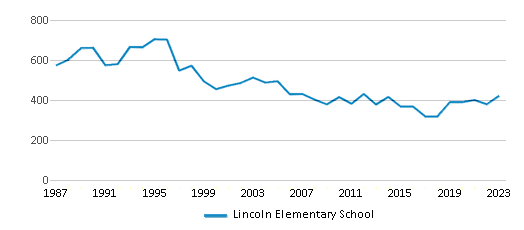
Gender %

Total Classroom Teachers
20 teachers
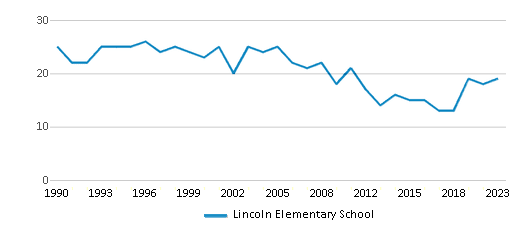
Students by Grade
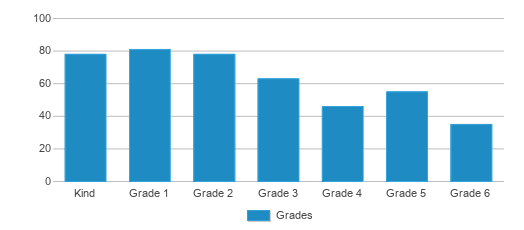
School Rankings
Lincoln Elementary School ranks within the bottom 50% of all 9,602 schools in California (based off of combined math and reading proficiency testing data).
The diversity score of Lincoln Elementary School is 0.10, which is less than the diversity score at state average of 0.63. The school's diversity has stayed relatively flat over five school years.
Overall Testing Rank
#7843 out of 9602 schools
(Bottom 50%)
(Bottom 50%)
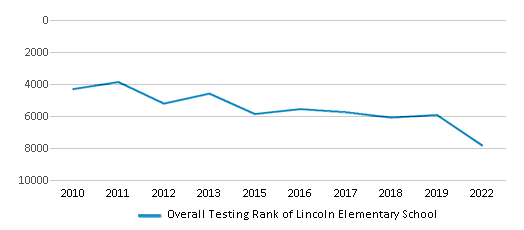
Math Test Scores (% Proficient)
15-19%
33%
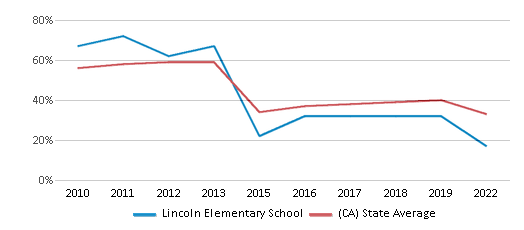
Reading/Language Arts Test Scores (% Proficient)
20-24%
47%

Science Test Scores (% Proficient)
≤10%
29%
Student : Teacher Ratio
22:1
21:1
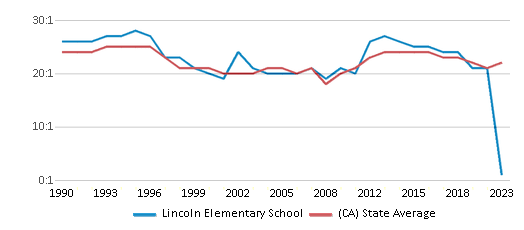
American Indian
n/a
1%
Asian
1%
12%
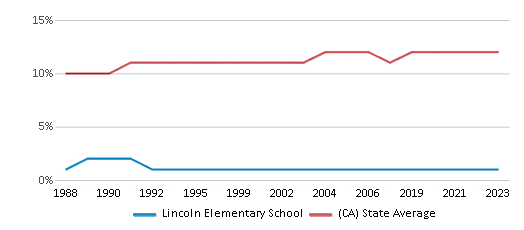
Hispanic
95%
56%
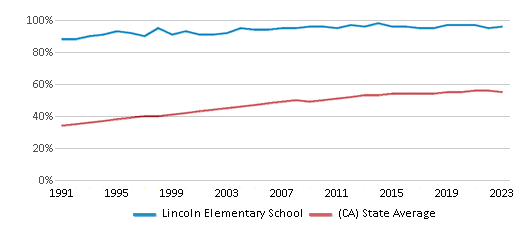
Black
1%
5%
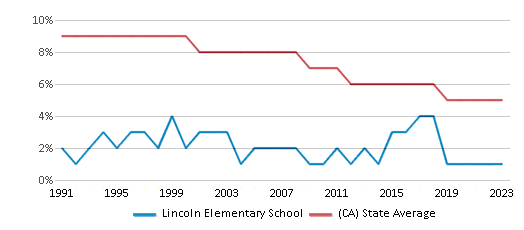
White
2%
20%
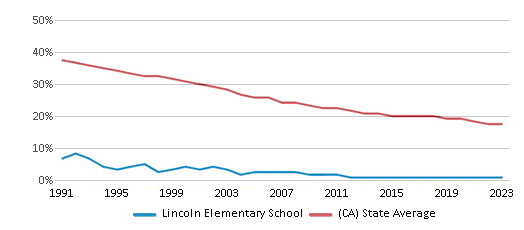
Hawaiian
n/a
n/a
Two or more races
1%
6%
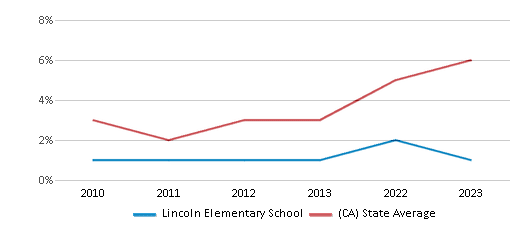
All Ethnic Groups
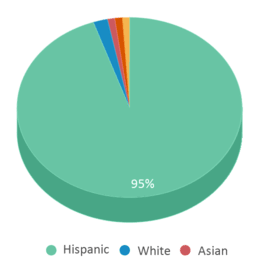
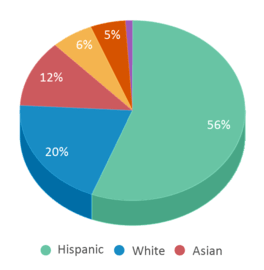
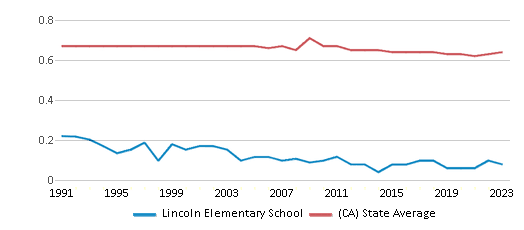
Eligible for Free Lunch
84%
54%
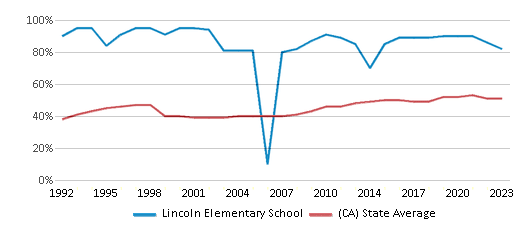
Eligible for Reduced Lunch
10%
8%
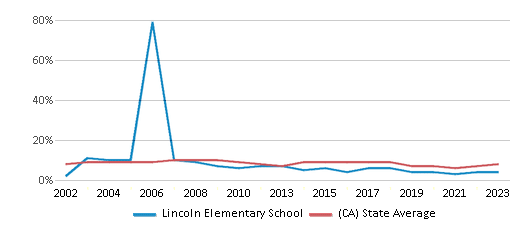
School Statewide Testing
School District Name
Source: National Center for Education Statistics (NCES), CA Dept. of Education
Profile last updated: 02/09/2025
Frequently Asked Questions
What is Lincoln Elementary School's ranking?
Lincoln Elementary School is ranked #7843 out of 9,602 schools, which ranks it among the bottom 50% of public schools in California.
What percent of students have achieved state testing proficiency in math and reading?
15-19% of students have achieved math proficiency (compared to the 33% CA state average), while 20-24% of students have achieved reading proficiency (compared to the 47% CA state average).
How many students attend Lincoln Elementary School?
436 students attend Lincoln Elementary School.
What is the racial composition of the student body?
95% of Lincoln Elementary School students are Hispanic, 2% of students are White, 1% of students are Asian, 1% of students are Black, and 1% of students are Two or more races.
What is the student:teacher ratio of Lincoln Elementary School?
Lincoln Elementary School has a student ration of 22:1, which is higher than the California state average of 21:1.
What grades does Lincoln Elementary School offer ?
Lincoln Elementary School offers enrollment in grades Kindergarten-6
What school district is Lincoln Elementary School part of?
Lincoln Elementary School is part of El Centro Elementary School District.
School Calendar
View the Lincoln Elementary School yearly calendar below. Note key dates such as:
Event
Date
First Day of Asian Pacific American Heritage Month (Events)
May 01, 2025 (Thursday)
First Day of LGBTQ+ Pride Month (Events)
June 01, 2025 (Sunday)
First Day of Hispanic Heritage Month (Events)
September 15, 2025 (Monday)
First Day of American Indian Heritage Month (Events)
November 01, 2025 (Saturday)
School Reviews
5 3/23/2020
I have wonderful many memories of Lincoln Elementary, having attended there in 4th and fifth grades, around 1957 through 1959. Mrs. Russell stands out in this seventy-year-old's memory as a wonderful teacher, bright and very musical, who left a lifetime impression on me. I love this city. The steep and dismal decline of El Centro, as reflected in the crime rate, lack of diversity and the test scores here is a source of deep grief to me. What went wrong? Best wishes.
Review Lincoln Elementary School. Reviews should be a few sentences in length. Please include any comments on:
- Quality of academic programs, teachers, and facilities
- Availability of music, art, sports and other extracurricular activities
Recent Articles

What Is A Charter School?
Explore the world of charter schools in this comprehensive guide. Learn about their history, how they operate, and the pros and cons of this educational innovation. Discover key facts about charter schools, including admission policies, demographics, and funding, as well as what to look for when considering a charter school for your child.

10 Reasons Why High School Sports Benefit Students
Discover the 10 compelling reasons why high school sports are beneficial for students. This comprehensive article explores how athletics enhance academic performance, foster personal growth, and develop crucial life skills. From improved fitness and time management to leadership development and community representation, learn why participating in high school sports can be a game-changer for students' overall success and well-being.

February 05, 2025
Understanding the U.S. Department of Education: Structure, Impact, and EvolutionWe explore how the Department of Education shapes American education, from its cabinet-level leadership to its impact on millions of students, written for general audiences seeking clarity on this vital institution.





